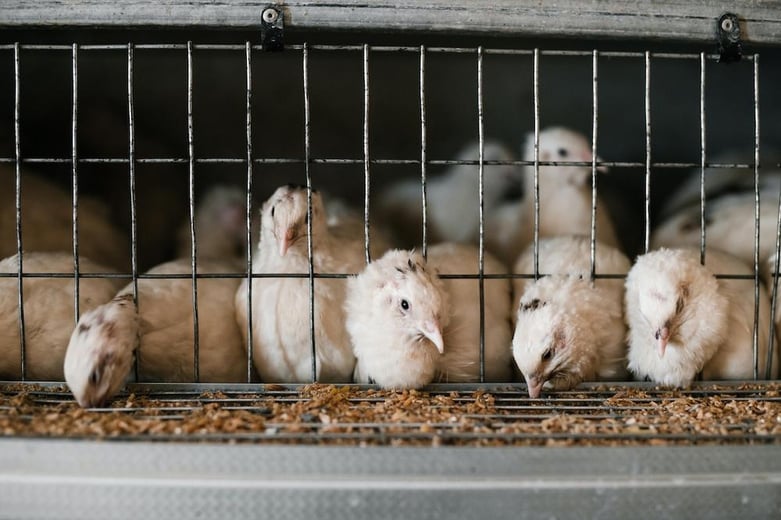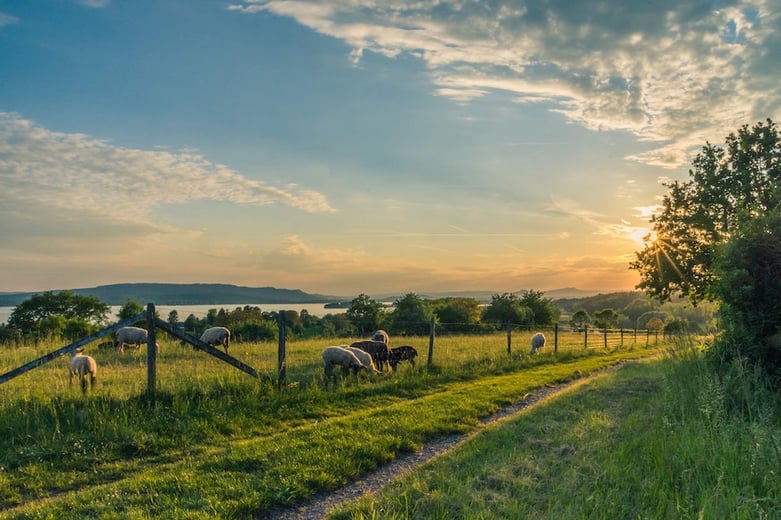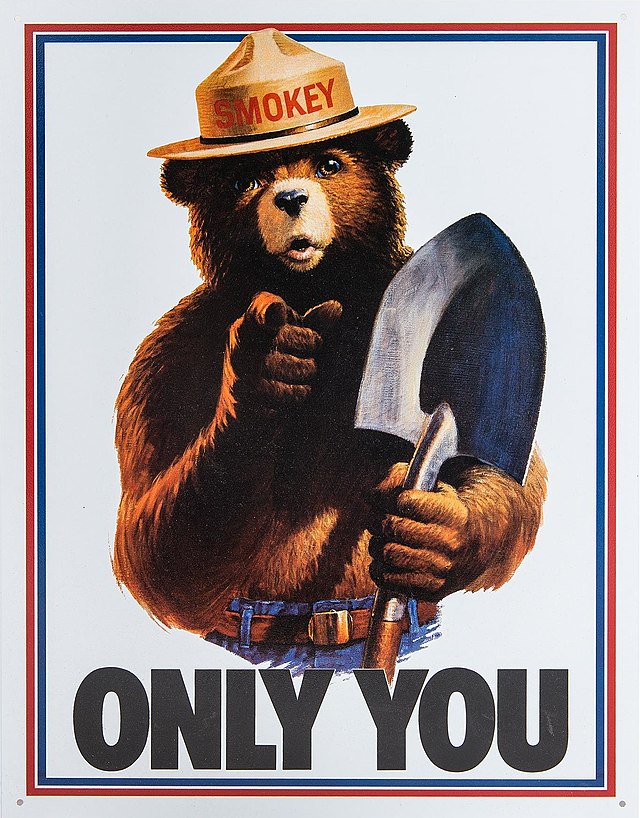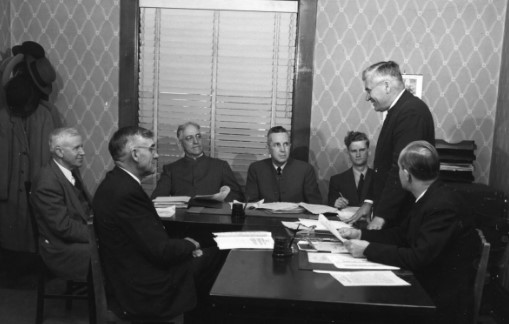In 2003, we created a video about a pig escaping a farm.
While The Meatrix may appear a bit corny by today’s standards, it was a huge hit at the time of its release, reaching 15 million viewers worldwide and winning awards from SXSW, The Webbys, the Web Marketing Association, and other organizations. It helped to raise awareness of factory farming and the brutal effects, both direct and secondary, that this approach to meat production has on animals, communities, our environment, and our health.
How did The Meatrix go viral in a time before social media made it quick and easy to share content? And what can this nearly 20-year-old Flash cartoon teach us about marketing the urgent issues that face our culture and our planet?
How to Sell Dead Bodies
In the early 2000s, when this video was first released into the wild, meat consumption was at a fever pitch. For instance, economies of scale and supply-side enhancements were driving the price of poultry down, as consumers became richer and demand for chicken continued to rise.
Food marketers—and in particular those working for fast-food conglomerates—capitalized on and promoted increased demand with advertisements that emphasized the positive experiences associated with eating cheap, readily available meat. McDonalds’ “I’m lovin it” campaigns and other feel-good incentives were ubiquitous. Meat was tasty, affordable, and easy to find. It seemed like a win-win for everyone.
But, to quote The Meatrix, such slogans were based on the “lies we tell ourselves about where our food comes from.”
Good branding often involves creating a mascot and branding a product to humanize it and make it relatable. This presents a problem for meat producers, whose “products” are living creatures with at least some capacity to feel discomfort, pain, and fear as they are turned into food. To get around the issue of animal suffering, fast-food marketing strategies will frequently position meat as something delicious and self-contained—abstracted from the organic whole of the creature it was harvested from.
The Meatrix, created to draw attention to the harmful realities of factory farming, took a different approach.
Part of the short’s success had to do with the way it tapped into the zeitgeist of late Web 1.0. In line with other viral cartoon content from the pre-YouTube era—think “salad fingers” or “Charlie the unicorn,” for instance—The Meatrix juxtaposed a glib, entertaining façade with a dark, macabre underside. In doing so, the cartoon fed a growing affinity for short videos that mixed cartoonish bright colors with grim or twisted subplots.
More bluntly, the short made the horrors of factory farming more accessible to a wide audience by drawing parallels between farm animals and well-known characters from The Matrix, a highly popular film series at the time. In the video, the imprisonment and harvesting of animals en masse were compared with a futuristic post-apocalyptic storyline where the value of human lives is reduced to their viability as a battery-like energy source used for running machines—making the dark side of factory farming obvious to even the most casual viewer.
As important as that message was nearly two decades ago, it has gained new urgency over the last few years…
Going Viral
Re-watching this video after 2020, one can’t help but notice the reference to a pandemic.
The grave reality told to us by “Moopheus” is that factory farming can lead to “an epidemic that cannot be stopped.” As it turned out, Moopheus’ portrayal as a guiding sage with prophetic insight was very much on the nose (or snout?). Could factory farming—and the intensive, unhygienic interaction between humans and animals it requires—be correlated with today’s pandemic?

Evidence suggests that factory farming has been a huge catalyzer for COVID-19. In 2020, for instance, Denmark killed millions of its captive mink population, because the animals were catching COVID, evolving it, and then creating a risk of a new strain which then could spill over to humans. Moreover, it is widely held that the 1918 Spanish Flu was spread from birds via pigs to man, ebola is likely to have come from a bat, and many other diseases (6 out of every 10 infectious diseases, to be precise) stem directly from human/animal interaction.
As animals are packed closely together and exposed to high levels of stress in factory farms, they suffer and become more prone to illness and diseases. In response, factory farms pump strong antibiotics into their captive animals, which only serves to delay and exacerbate the issue as virulent superbugs evolve. This is an escalating war between a competitive meat economy and evolving viruses, and the casualties could very well be future generations of humans and animals alike.
Today we face a global pandemic and have barely been able to cope, even with a quick response and excellent vaccine technology. Yet, what if all these advances are for the birds? Might this pandemic simply be a dress rehearsal for something worse to come? If we continue down the path of factory farming, the effects to our species and to our environment could very well be catastrophic.
Can It Be Stopped?
So what can we, as storytellers, do to address the evolving dangers of factory farming? How can we accomplish in the 2020s what The Meatrix helped to accomplish in the early 2000s?
What can be done here and now is to actively seek out ethically-sourced meat from farms which treat their animals (and their land) with dignity and respect, and allow them to lead a full life in healthy conditions, respectful of the holistic local unit which they all comprise. These practices are better for both animals and for consumers, and provide a happy medium between the brutality of factory farming practices and an all-out ban on meat.

Yet these kinds of products don’t always fall comfortably into the price range of the average consumer, and the margin might not seem worth the effort to those with bills to pay. How can we make it clear that ethical meat production is indeed worth the additional cost? How do we help to enable free-range farms to achieve the necessary scale to compete?
As marketers, it is essential that we raise awareness, which must lead to a societal and economic shift in attitudes. The silent inhumanity and devastation of factory farming practices needs to be brought into sharper focus for this shift to occur.
At Free Range, we know that it is necessary to start with understanding the context of the problem, which involves multiple players with economic incentives and stories. It is important to approach the issue as a learner and to observe where people stand in their cultures and why they make the decisions they do.
For example, what factors go into a consumer’s decision to purchase a certain type and brand of meat at the grocery store? Something as seemingly innocuous as daily retail grocery shopping has surprising importance at a large scale. What shapes the perspective of the user? Is it merely the price of a product? Or are there ethical considerations they are not aware of which can lead to a tipping point? Maybe a meme or a thought experiment stood out to them in the past which could raise their interest in mindful shopping?
Secondly, once we recognize these issues, we begin to identify and explore ideas and concepts which can be both simple and far out. Maybe we consider what movies and TV shows are most popular today and how we might leverage archetypes which are strong in the culture at this time. Maybe we appeal to shock value to help people to recognize that the wellbeing of animals is equivalent to their own well-being, which is an idea often employed by PETA in many of their campaigns. On the other hand, we can also convey a sense of empowerment and show the value of small acts of love and healing to our planet, much like Kiss the Ground has done.
Finding the right balance and what kind of content will really strike a nerve in the culture is fundamental to create and launch a good campaign for the good of the planet and our future with it. If we can make even a small contribution in raising awareness and concern for the future of animals and global health, future generations will benefit. It’s time to begin to open our eyes to how we can do good in difficult times with effective marketing.




